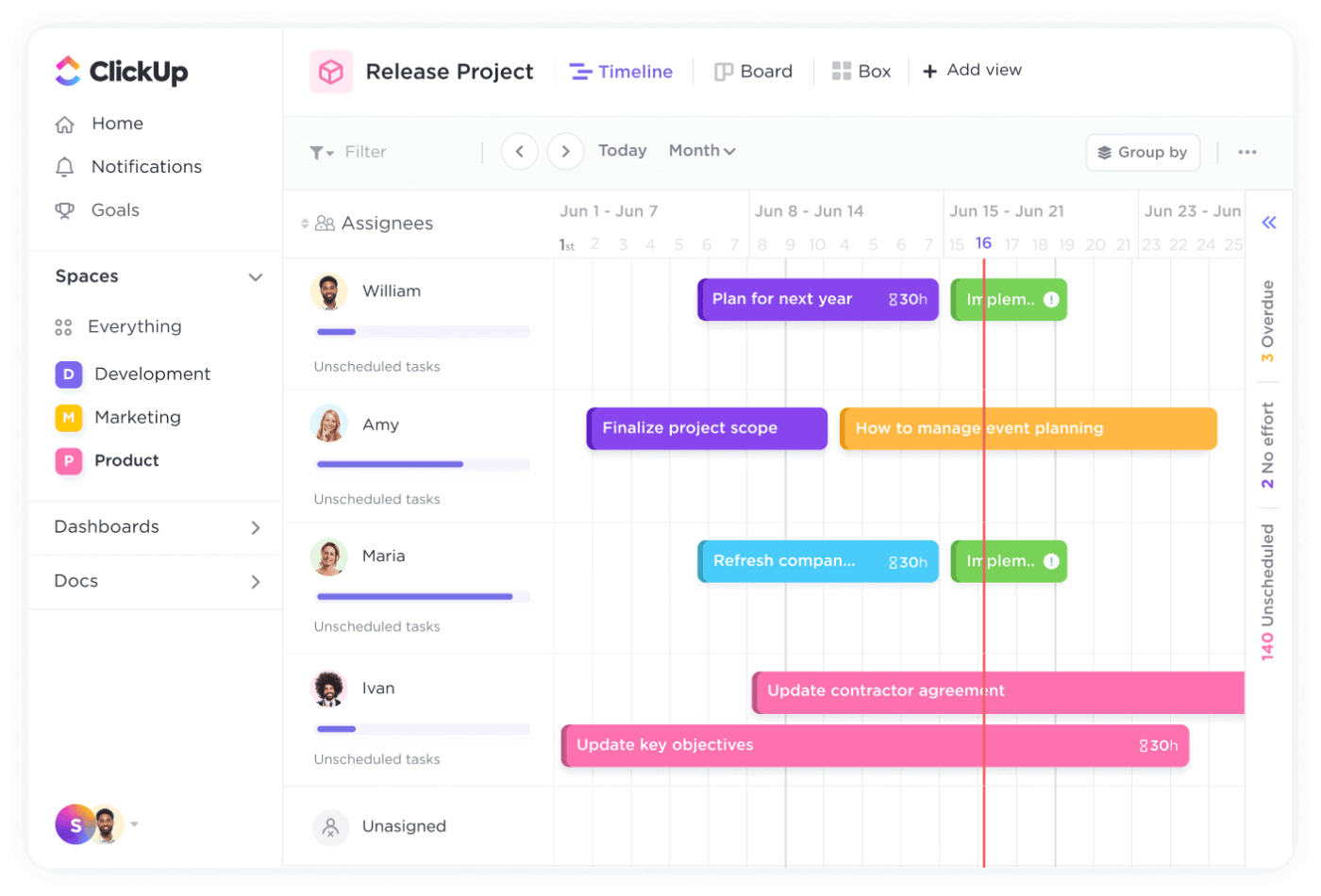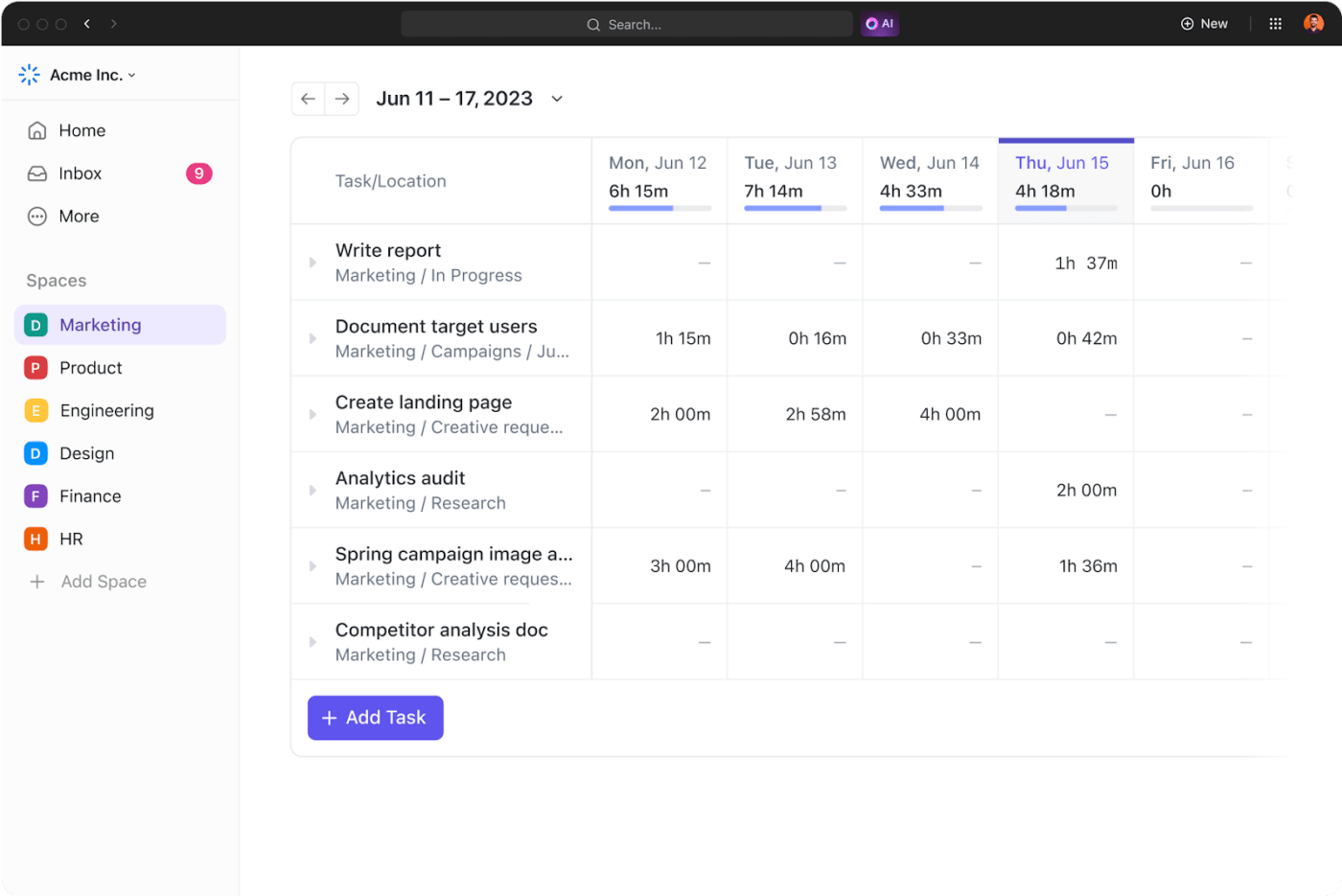هل تشعر بالإرهاق من قوائم المهام التي لا تنتهي؟ يتشارك الملايين منا هذا الشعور. نشعر أن 24 ساعة لا تكفي لإنجاز كل شيء!
ولكن هل فكرت أن عدد المهام قد لا يكون المشكلة الحقيقية؟ قد يكون السبب هو أسلوبك في إدارة الوقت .
إذا كان هذا يبدو لك، فإن وضع ميزانية للوقت يمكن أن يكون وسيلة رائعة بالنسبة لك لتتمكن من السيطرة على كومة مهامك. قد يكون هذا هو المفتاح لاستعادة السيطرة على جدولك الزمني وزيادة الإنتاجية.
سواءً كنت محترفًا مشغولاً أو طالبًا أو والدًا يدير شؤون المنزل، يمكن أن تساعدك الميزنة الفعالة للوقت على تحديد أولويات المهام وتخصيص وقت لما هو مهم حقًا.
في هذه المقالة، سنستكشف فوائد وضع ميزانية للوقت والاستراتيجيات العملية لتطبيقها في روتينك وفوائدها في الحياة اليومية.
ما هي ميزانية الوقت؟
ميزانية الوقت هي طريقة تخطيط وتخصيص وقتك لمختلف المهام أو الأنشطة أو المشاريع في فترة معينة. وهذا أسلوب إدارة الوقت تتضمن تنظيم مهامك وترتيب أولوياتها بناءً على أهميتها ومواعيدها النهائية. وهو يساعدك على إدارة وقتك الشخصي والمهني بكفاءة أكبر.
يشبه إعداد ميزانية الوقت إعداد الميزانية المالية في العديد من النواحي. فكما تضع ميزانية لأموالك من أجل المشتريات أو الالتزامات المهمة، فإنك تضع ميزانية لوقتك بحيث يكون لديك ما يكفي لإنفاقه عندما يكون ذلك مهمًا.
يساعدك وضع ميزانية فعالة للوقت على تحقيق أقصى استفادة من أنشطتك اليومية. فهي تتيح لك التركيز على المهام ذات الأولوية العالية وتقليل الوقت الضائع في المهام غير المهمة.
من خلال تخصيص الوقت للمهام وفقًا لأهميتها ومواعيدها النهائية، يمكنك بسهولة الوفاء بمواعيدك النهائية دون أي استعجال أو توتر في اللحظة الأخيرة.
والأكثر من ذلك؟ تسمح لك هذه الطريقة أيضًا بتحديد الأنشطة التي تستهلك وقتك في يومك. من خلال تحديد الأنشطة التي تستهلك وقتك دون داعٍ، يمكنك التخلص منها أو إلغاء أولويتها وإتاحة المزيد من الوقت لنفسك.
💡 نصيحة محترف: إتقان استخدام الموارد و تسوية الموارد هي طرق ممتازة لتسليم المشاريع في الوقت المحدد والميزانية، خاصةً إذا كان فريقك يعاني من صعوبة في إدارة الوقت والميزانية.
فهم الميزانية الزمنية
تخيّل أنك مسوّق رقمي، وعليك كتابة خمسة تعليقات على وسائل التواصل الاجتماعي ونسخة بريد إلكتروني، وحضور اجتماع، وإجراء بحث عن السوق لحدث قادم للعلامة التجارية، وإنشاء مخطط تفصيلي لكتاب إلكتروني في يوم واحد.
كيف ستنهي مهامك في يوم واحد؟
- ابدأ العمل على أي مهمة تبدو أسهل أو أصغر بحيث تنهيها بسرعة، ثم أنهِ كل مهمة واحدة تلو الأخرى، على أمل أن تنجزها كلها في الوقت المحدد
- ابدأ بترتيب أولويات جميع مهامك وفقًا لمواعيدها النهائية، ثم ابدأ العمل على المهام التي تحتاج إلى إنجازها بشكل أسرع
- اترك كل شيء حتى اللحظة الأخيرة ثم تظاهر بالمفاجأة لأنك لم تنجز أي شيء
- الذعر، والإرهاق، وعدم إنجاز أي شيء
حتى لو كنت لا تفعل ذلك بالضرورة كل يوم، فأنت تعلم أن الخيار (ب) يبدو الخيار الأكثر إنتاجية
وضع ميزانية للوقت
إنه نهج شامل لتنظيم وقتك واستخدامه بفعالية لتحقيق أهداف محددة.
إنه مشابه لحجب الوقت، وتقنية بومودورو، ومصفوفة أيزنهاور، و مصفوفة إدارة الوقت أو طريقة إنجاز المهام (GTD) لإدارة الوقت.
أهمية وضع ميزانية للوقت
تجبرك ميزانية الوقت على اتخاذ جميع القرارات الحاسمة والمتعلقة بالمهام المتعلقة بيومك قبل أن يبدأ. وهذا يضمن لك عدم الاضطرار إلى اتخاذ قرارات متسرعة أثناء التنقل.
تسمح لك ميزانية الوقت بتتبع الوقت المستغرق في المهام المختلفة على مدار اليوم. وبهذه الطريقة، يمكنك التأكد من أنك تستغل ساعاتك الأكثر إنتاجية في إنجاز أعمالك الأكثر أهمية وتترك المهام الأقل أهمية لوقت لاحق.
على سبيل المثال، أنت لا تحب الذهاب إلى طبيب الأسنان، ولكن أسنانك تؤلمك. ابدأ يومك بموعد مع طبيب الأسنان. تخلص من أقل الأشياء المفضلة لديك في الصباح حتى تتمكن من الاستمتاع ببقية اليوم.
وبهذه الطريقة، يساعدك تنظيم الوقت على إنجاز المزيد من المهام والشعور بالإنجاز طوال يومك!
عملية وضع ميزانية للوقت
التخطيط لوقتك بفعالية يمكن أن يجعل يومك أكثر سلاسة.
فيما يلي خطوات إنشاء ميزانيات متوازنة ودقيقة للوقت.
الخطوة 1: تحديد الأولويات الرئيسية
أنشئ قائمة بجميع المهام التي لديك لهذا اليوم. ثم ابدأ بتحديد المهمة الأكثر حساسية للوقت.
هل هناك مهام أو مشاريع محددة تحتاج إلى اهتمامك اليوم؟ هل لديك مهام يمكنك تفويضها لشخص آخر حتى تتمكن من التركيز على أشياء أخرى؟ هل يمكن إنجاز بعض المهام في وقت لاحق بدلاً من ذلك؟
حدد هذه الأولويات الرئيسية للتركيز على ما هو أكثر أهمية في ذلك اليوم.
الخطوة 2: خصص وقتًا حصريًا لكل مجال
بمجرد أن تعرف أولوياتك، خصص فترات زمنية محددة لكل منها.
على سبيل المثال، إذا كان العمل وممارسة الرياضة والوقت المخصص للعائلة من أولوياتك، خصص أجزاء منفصلة لكل أولوية خلال يومك.
قسّمها بناءً على مدى قدرتك على العمل عليها في أي وقت من اليوم. على سبيل المثال، إذا كنت من الأشخاص الذين يحبون الصباح، فيمكنك تخصيص ساعة واحدة في الصباح لممارسة الرياضة، ثم تخصيص ساعتين أو ثلاث ساعات تالية للعمل المركز على المهام الحرجة عندما تكون لديك طاقة أكبر.
الخطوة 3: حدد الأولويات وأضف مخزونًا زمنيًا مؤقتًا
بمجرد قيامك بإدراج جميع المهام وحجز وقتك لكل منها، قم بتعيين الأولويات داخل كل كتلة زمنية. يمكنك وضع علامة على المهمة الأكثر أهمية على أنها "P1"، ثم ضع علامة على المهمة الأقل أهمية على أنها "P2"، وهكذا.
حدد مستويات الأولوية لكل مهمة بحيث تعرف المهام التي يجب عليك إكمالها في ذلك الوقت.
من الممارسات الجيدة أيضًا إنشاء فواصل زمنية بين الأنشطة لمراعاة التأخيرات أو الفواصل غير المتوقعة ومنع تجاوز ميزانيتك.
الخطوة 4: قم بمراجعة وتعديل ميزانيتك الزمنية بانتظام
أخيرًا، راجع بانتظام كيف تقضي وقتك. هل تلتزم بجدولك الزمني المخطط له؟ هل أنت بحاجة إلى تعديل مخصصاتك بناءً على ما ينجح وما لا ينجح؟
حافظ على المرونة وغيّر جدولك الزمني مع تطور المهام والالتزامات والأولويات.
إذا كنت لا تزال تواجه صعوبة في تحديد أولويات مهامك أو تشعر أنه يمكنك جعل يومك أكثر كفاءة، فلا تقلق! قالب تخصيص الوقت في ClickUp هو نموذج جاهز للاستخدام للمبتدئين مثلك الذين يرغبون في تخطيط وإدارة مشاريعهم بثقة.
أكمل جميع مهامك اليومية بكل ثقة بمساعدة قالب تخصيص الوقت من ClickUp
يمكن أن يوفر قالب الميزانية الزمنية المتوازنة هذا هيكلاً ووضوحًا ليومك. يمكن أن يساعدك في الحفاظ على تركيزك وعلى المسار الصحيح من خلال طرق عرض المهام المرئية والقابلة للتخصيص بدرجة كبيرة. يمكنك عرض جدولك الزمني في طريقة عرض قائمة المهام، وتخصيص الوقت، ودليل البدء.
لتتبع التقدم الذي تحرزه أنت وأعضاء فريقك، يمكنك وضع علامة على مهامك على أنها مكتملة أو قيد التنفيذ أو قيد التنفيذ أو قيد الإنجاز.
بالإضافة إلى ذلك، استخدم القالب من أجل:
- إنشاء وتعيين مهامك بنفسك في طريقة عرض قائمة المهام
- خصص دقائق أو ساعات محددة لكل مهمة وتأكد من عدم تفويت أي مواعيد نهائية مهمة باستخدام طريقة عرض تخصيص الوقت
- احصل على النصائح والحيل المفيدة لتحقيق أقصى استفادة من تخصيص الوقت باستخدام طريقة عرض دليل البدء
- تحديث حالات المهام أثناء إحراز تقدم والانتقال إلى المهمة التالية
إذا لم ينجح شيء ما، يتيح لك القالب تعديل جدولك الزمني حسب الحاجة.
الأخطاء الشائعة في إعداد الميزانية الزمنية وكيفية تجنبها
على الرغم من أن العملية المكونة من أربع خطوات تجعل عملية إعداد ميزانية الوقت تبدو بسيطة وسهلة، إلا أنك قد تواجه بعض التحديات الشائعة أثناء إنشاء ميزانية الوقت.
عدم استخدام الأدوات الرقمية
يعتمد بعض الأشخاص فقط على الملاحظات الذهنية أو القوائم الأساسية أو تطبيق تتبع الوقت لتذكيرهم بمهامهم. ولكن عندما نفعل ذلك، فإننا غالبًا ما ننسى المهام أو المواعيد النهائية المهمة.
لتجنب ذلك، استخدم الأدوات الرقمية مثل التقويمات أو تطبيقات إدارة المهام أو برامج الإنتاجية. يمكن أن تساعدك هذه الأدوات على تنظيم المهام، وتعيين التذكيرات، وإدارة التقويم والجداول الزمنية للمشاريع، وحتى تحليل كيفية قضاء وقتك.
يمكن لتطبيقات مثل ClickUp و Asana و Trello تنظيم أيامك وتبسيط عملية اتخاذ القرارات المتعلقة بالمهام، مما يعزز إدارة وقت المشروع الجهود

وضع ميزانية للوقت، وجدولة المهام في التقويم الخاص بك، والتحقق من التبعيات، وتخطيط الجداول الزمنية في مكان واحد - باستخدام منصة ClickUp لإدارة المشاريع
الإفراط في الميزانية
بالنظر إلى الإطار الزمني، من الشائع المبالغة في تقدير ما يمكنك إنجازه. يمكن أن يؤدي تكرار ذلك إلى الإحباط والتوتر إذا تأخرت عن الجدول الزمني.
لتجنب المبالغة في الميزانية، حاول أن تكون واقعيًا بشأن الوقت اللازم لإنجاز مهامك. قم ببناء وقت احتياطي لأي انقطاعات أو تأخيرات غير متوقعة في جدولك الزمني.
💡 نصيحة احترافية: إذا كنت لا تعرف مقدار الوقت الذي يجب تخصيصه للمهام، فابدأ بتخصيص وقت أقل. ثم قم بإجراء تعديلات بناءً على أدائك الفعلي لاحقًا.
إهمال مراجعة الميزانية وتعديلها
بمجرد إنشاء ميزانية زمنية، يجب عليك مراجعة مقدار الوقت الذي تخصصه لكل مهمة بانتظام. حدد وقتًا أسبوعيًا أو شهريًا لتقييم كيفية استخدامك لوقتك. حدد ما الذي يعمل بشكل جيد وما يحتاج إلى تحسين. إذا كان الوقت الذي تخصصه أقل أو أكثر مما تحتاجه، فقم بتعديله وفقًا لذلك.
يمكن أن يؤدي إهمال هذه الخطوة إلى ميزانية زمنية لا تتماشى مع الواقع وتفسد جداول إنجاز المشروع وتسليمه.
فوائد ومزايا الميزانية الزمنية ## فوائد ومزايا الميزانية الزمنية
هناك العديد من الفوائد لإدارة يومك من خلال وضع الميزانية الزمنية. دعنا نستعرض بعضًا منها معًا:
1. قيمة الوقت: فهم وقت ذروة الأداء الخاص بك
يساعدك وضع ميزانية للوقت في التعرف على الأوقات التي تكون فيها في أفضل حالاتك خلال اليوم. لدينا جميعًا أوقات نكون فيها في قمة التركيز والنشاط وأوقات أخرى تنخفض فيها طاقتنا. يمكنك مواءمة مهامك الأكثر أهمية مع ساعات ذروة أدائك من خلال وضع ميزانية لوقتك.
على سبيل المثال، إذا كنت من محبي السهر ليلاً، يمكنك جدولة المهام المعقدة أو العمل الإبداعي في الليل (كلما أمكن ذلك) لتحقيق أقصى قدر من الفائدة وزيادة الإنتاجية.
2. التغلب على نقاط الضعف وتحديد مستويات الأولوية
من خلال وضع ميزانية للوقت، يمكنك تحديد المهام أو المشاريع التي تواجه صعوبة في إكمالها. قد تماطل في أنواع معينة من المهام لأنها مملة أو يصعب إنهاؤها. أو ربما يتشتت انتباهك بسهولة.
يمكنك التغلب على نقاط الضعف هذه من خلال تحديد مستويات الأولوية وتخصيص فترات زمنية محددة لإنجازها. يضمن هذا النهج حصول المهام الحاسمة على الاهتمام الذي تستحقه، حتى لو لم تكن مفضلة لديك.
إذا كنت تستخدم ClickUp لإدارة مهامك اليومية، فربما تكون على دراية بميزة تجعل من السهل تحديد أولويات المهام. أولويات مهام ClickUp يساعدك على تخطيط مهامك المستقبلية بمساعدة أربع علامات - عاجلة، وعالية، وعادية، ومنخفضة.

قم بفرز مهامك حسب الأولوية عن طريق وضع علامة عليها والاطلاع على المهام الأكثر أهمية في سير عملك باستخدام ميزة أولويات المهام في ClickUp
يمكنك إسقاط العناصر ذات الأولوية العالية في علبة المهام الخاصة بك حتى تتمكن من العمل عليها قبل المهام الأخرى. هذه الميزة مفيدة إذا كنت تعمل في فريق وترغب في إعلام أعضاء فريقك بأولويات يومك.
يمكنك أيضًا تعيين مرشحات شخصية أو مرشحات مساحة العمل لتواريخ الاستحقاق أو الأولويات ثم حفظ المرشحات أو تعديلها أو حذفها أو مشاركتها.
3. تجنب التسرع في الأنشطة وضمان تحقيق أهداف واقعية
عندما تضع ميزانية جيدة لوقتك، فإنك تتجنب التسرع الأعمى في الأنشطة أو المهام أو الالتزامات غير المتوقعة. لا يمكنك القيام بعمل إضافي إلا إذا كان الوقت حساسًا. وهذا يساعد على تنظيم يومك وتجنب الإرهاق.
يمكنك أيضًا تقييم مقدار الوقت الذي تتطلبه كل مهمة بشكل واقعي وتخصيص وقتك وفقًا لذلك.
كما يساعدك تحديد سرعة إنجازك أيضًا على تحديد أهداف قابلة للتحقيق ويمنعك من الضغط النفسي الناتج عن حشر الكثير من الوقت في إطار زمني محدود. ومن خلال تحديد سرعة إنجاز المهام، فإنك تزيد من احتمالية إكمال المهام بدقة وفي الموعد المحدد.
4. زيادة الوعي الذاتي وتتبع التقدم المحرز
هل تتذكر عندما كان لدينا واجبات منزلية علينا إنجازها خلال الصيف عندما كنا أطفالاً في المدرسة؟ كنا نقضي أسابيع غافلين عن المواعيد النهائية ثم ننتهي منها كلها في النهاية، ونتعرض للتوبيخ بسبب إهمالنا.
كان من شأن وضع ميزانية جيدة لوقتنا أن ينقذنا (وينقذ والدينا) من الذعر في اللحظة الأخيرة. وكان من شأنه أن يمنحنا حق التفاخر بأننا أول من ينجز بعض المشاريع. كما أنه كان سيمنحنا أيضًا نظرة ثاقبة للأنشطة التي كنا نستمتع بها - والأنشطة التي كنا نمقتها.
إن وضع ميزانية للوقت يشجعك على الوعي الذاتي من خلال جعلك واعياً بكيفية قضاء وقتك. تكتسب نظرة ثاقبة على عاداتك ونقاط قوتك والمجالات التي تحتاج إلى تحسين.
بالإضافة إلى ذلك، يوفر لك تتبع التقدم الذي تحرزه مقابل الجداول الزمنية المخطط لها إحساسًا بالإنجاز ويبقيك مسؤولاً. إنه يشبه وجود خارطة طريق تبقيك على المسار الصحيح نحو أهدافك.
5. زيادة التحفيز وفهم متى تضع حدوداً
إن وضع حدود لوقتك للأنشطة المختلفة يبني الانضباط والتحفيز. فمعرفة أن لديك وقتًا مخصصًا للعمل والاسترخاء والأنشطة الشخصية يشجعك على تحقيق توازن صحي بين جميع جوانب الحياة.
يسمح لك ذلك ببذل قصارى جهدك للمهمة التي بين يديك ويبقيك متحمسًا لإنهائها.
كما يساعدك أيضًا على معرفة متى تقول لا أو تفوض المهام التي لا تتماشى مع أولوياتك. هذا الوضوح يمنع الإرهاق ويضمن لك استثمار طاقتك في المجالات الأكثر أهمية.
ضمان وضع ميزانية زمنية ناجحة
يتضمن وضع ميزانية ناجحة للوقت التخطيط الاستراتيجي والوعي الذاتي وتحليل الأداء الذاتي والمرونة. وفيما يلي بعض نصائح لإدارة الوقت ووضع الميزانية لتحقيق توازن أفضل بين العمل والحياة
- قم بتفويض المهام التي يمكن أن يقوم بها شخص آخر في فريقك. سيخفف ذلك من عبء العمل ويوفر وقتًا لأعمال أخرى مهمة
- ضع حدوداً واضحة بين العمل والحياة الشخصية. حدد ساعات عملك والتزم بها ما لم يكن ذلك ضرورياً
- تجنب الإفراط في الالتزامات بنفسك. تعلم أن ترفض بأدب الطلبات التي لا تتماشى مع أولوياتك أو قيمك
- خصصي وقتًا للرعاية الذاتية للأنشطة التي تجدد طاقتك البدنية والذهنية والعاطفية، مثل ممارسة الرياضة والهوايات
ستلاحظ الآثار الإيجابية لميزانية الوقت بمجرد أن تبدأ في ممارستها. إليك بعض الأشياء التي ستلاحظها عند استخدامك لميزانية الوقت بشكل صحيح:
- ستصبح أكثر إنتاجية عندما تبدأ في التركيز على المهام ذات الأولوية القصوى وتقليل الوقت الضائع في الأنشطة الأقل أهمية
- من خلال وجود خطة وهيكل واضحين لوقتك، ستشعر بتوتر وقلق أقل مرتبطين بعدم اليقين أو أعباء العمل المرهقة
- ستحصل على تكامل أفضل بين العمل والحياة الشخصية، مما يضمن لك وقتاً مخصصاً للعمل والأنشطة الشخصية
- ستكون قادرًا على تكريس المزيد من الطاقة والاهتمام لكل مهمة مما يؤدي إلى عمل بجودة أعلى إمكانيات إدارة الوقت في ClickUp توفر تتبع الوقت حيث يمكنك بدء الوقت وإيقافه، والانتقال بين المهام، وإضافة تفاصيل حول كيفية قضاء الوقت. اعرف أين خصصت وقتك من خلال التتبع العام واليدوي من سطح المكتب أو الأجهزة المحمولة.

تتبع الوقت مقابل كل مهمة بحيث يمكنك وضع ميزانية دقيقة لوقتك لنفس المهمة في المستقبل باستخدام ClickUp
ابدأ بتحديد أولوياتك. أنشئ مجموعات زمنية للمهام الرئيسية، وحدد أولوياتها، وتحقق منها في قائمتك أثناء قيامك بها.
من خلال التقويم، وجانت، والجدول الزمني، وعرض عبء العمل لجدولك الزمني، يمكنك عرض مهامك كما تريد، وتبقى مسؤولاً عن يومك.
ابدأ بتخصيص الوقت مع ClickUp اليوم
تُعد ميزانية الوقت طريقة ممتازة لتغيير طريقة إدارتك لأيامك وتحقيق أهدافك. من خلال تحديد أولويات واضحة، وتخصيص الوقت بشكل استراتيجي، ومراجعة خطتك بانتظام، يمكنك الحصول على العديد من الفوائد، بما في ذلك زيادة الإنتاجية وتقليل الضغط وتحسين التوازن بين العمل والحياة.
تساعدك موازنة الوقت على تحسين كفاءة العمل والتركيز والتحكم في وقتك. فهي تمكّنك من اتخاذ قرارات مستنيرة بشأن أين تستثمر طاقتك ومواردك، مما يؤدي إلى نتائج أكثر جدوى على الصعيدين المهني والشخصي.
تذكر أن وضع ميزانية فعالة للوقت يتطلب تقييمًا وتعديلًا مستمرًا. ابقَ متجاوبًا مع الأولويات والظروف المتغيرة. قم بتقييم تخصيص وقتك بانتظام، وحدد مجالات التحسين، وحدد توقعات معقولة، وقم بإجراء التعديلات اللازمة لتحسين جدولك الزمني لتحقيق النجاح.
الآن هو الوقت المناسب لاتخاذ الإجراءات اللازمة ودمج ميزانية الوقت في روتينك. استخدم أدوات مثل ClickUp لتبسيط عملية التخطيط وتحسين إنتاجيتك. اشترك في ClickUp وتحكم في وقتك اليوم!


